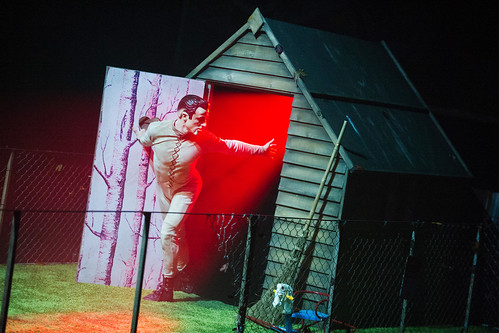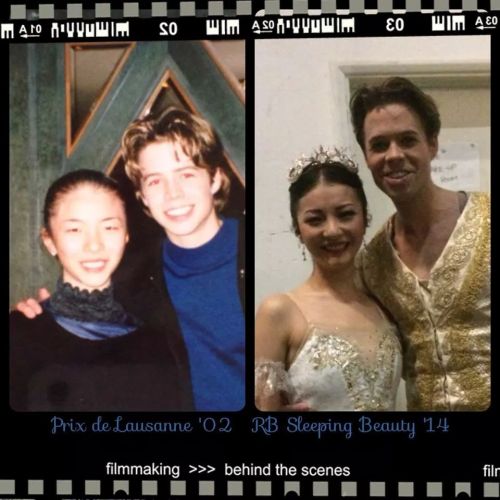I'm so sad to hear that Claudia Dean is leaving the Royal Ballet! She was absolutely fantastic as the Chosen Maiden in the Rite of Spring and as the Queen of the Wilis in Giselle, and I had her on my list of dancers to watch. I wish her all the best for her future! I hope she will keep up her endearing tweets and let us know what is going on in her life!
Saturday 24 May 2014
Tuesday 20 May 2014
Backstage with the Dancers of the Royal Ballet
I'm not generally an avid reader of the Daily Mail, but this article that goes backstage with some of the dancers of the Royal Ballet is very interesting!
 |
| Claudia Dean and Marcelino Sambe of the Royal Ballet ©Joe Plimmer |
Monday 19 May 2014
The Metamorphosis
I missed The Metamorphosis when it was performed at the Royal Opera House in early 2013. Luckily, it is now on DVD!
The Metamorphosis was performed in the Linbury Studio Theatre, it's venue for more experimental work, it seems. Arthur Pita's The Metamorphosis definitely falls into this category.
 |
| John Ross © |
Based on Franz Kafka's unsettling tale about Gregor Samsa, who awakes one morning to find himself "transformed in his bed into a monstrous vermin", it is probably the most nauseating thing I have ever seen in dance (and I mean this as a compliment).
Edward Watson's portrayal of this monstrous vermin is pure genius. As in Kafka's novella, we find him lying in his bed, tense limbs stretched upwards, fingers and toes wriggling like feelers. Like an insect trapped on its back, he struggles to turn over, twisting and writhing in a way that resembles nothing human. He crawls to the end of the bed and vomits a black liquid onto the floor. Then, hearing knocks at his door, he drags himself across the room, spreading the black liquid across its surfaces. By the end of this ballet, the entire stage will be transformed from a blindingly clean white to a brown, slippery mess.
 |
| John Ross © |
Watson evolves his character from from frightened, to curious, to self-loathing. In a particularly nightmarish scene (and the only departure from Kafka's original story), three monstrous insects covered from head to toe in a black liquid (treacle actually) crawl over the walls into Gregor's room and writhe across the floor. The scene marks a turning point in the plot, after which it becomes clear that there is no going back for Gregor. All the while, looking into his eyes, we truly believe he is a human trapped in an insect's body. When, in the end, he throws himself out of his window, we feel truly sorry for him. I can see why critics call Watson one of the most exciting dancers working in Britain today!
 |
| ©Tristram Kenton |
Arthur Pita's The Metamorphosis is a fantastic adaptation of Kafka's work. Personally, I found watching it even more engaging that reading it. It is a testament to power of dance to express deep and complicated emotions.
Tuesday 13 May 2014
Royal Ballet Tumblr
Just discovered this fantastic (fanmade) Tumblr account dedicated to the Royal Ballet. There are some great pictures! Like this one of Yuhui Choe and Matt Golding in 2002 and 2014.
Saturday 10 May 2014
Five Reasons why I Love ROH's Linbury Studio
Many people don't know that the Royal Opera House has a second stage in the basement. While not as glitzy as the main stage, the Linbury Studio Theatre is definitely worth checking out. Here are five reasons why:
1. Tickets never cost more than £25 and because it's a smaller venue, no matter where you sit, you get a great view.
 |
| Hansel and Gretel © ROH / Tristram Kenton |
2. The Linbury is home to some very experimental works. It's not just in choreography, music and stage design that the boundraries are pushed - the audience's emotional boundaries are put to the test too. Blood, Hansel and Gretel and the Metamorphosis are some of the most disturbing things I've seen in dance, and it was brilliant!
3. The Linbury hosts wonderful touring companies. This season I saw Ballet Black and the Northern Ballet. Next season, I am looking forward to the Ballet Boyz and the Rambert Dance company. It's an excellent opportunity to expand your dance horizon.
 |
| Yuhui Choe and Kenta Kura in The Human Edge. © Foteini Christofilopoulou |
4. My favourit Linbury works are the ones for which choreographers are commissioned to collaobarate with dancers of the Royal Ballet. It's a wonderful opportunity to see them up close and doing something different. Last week I saw Mayuri Boonham's The Human Edge, created for Royal Ballet's Yuhui Choe and Kenta Kura. It was stunning!
5. Finally, once a year, the Linbury stages "Draft Works", in which dancers from
within the ranks of the Royal Ballet create and perform their own work. It's so interesting ot see what the dancers come up with!
Tuesday 6 May 2014
The Sleeping Beauty vs The Winter's Tale
A recent article in the Guardian discusses whether the classic ballets, like Swan Lake, should be retired in favour of a more contemporary repertoire. My last two visits to the Royal Opera House helped shape my opinion.
In March and April, I saw two ballets at the Royal Opera House: The Sleeping Beauty, a classic, and The Winter's Tale, a brand new production. Both are programmatic ballets which follow a traditional three act format; both are love stories with happy endings; and both draw from the classical repertoire of ballet steps. Yet one left me feeling that ballet is a dated art form, while the other felt completely contemporary and relevant.
 |
| in The Winter's Tale Alice Pennefather |
 |
| Sarah Lamb and Steven McRae in The Skeeping Beauty Johan Persson |
 |
| Sarah Lamb and Steven McRae in The Winter's Tale Johan Persson |
In a fantastic interview on BBC's Hardtalk, Tamara Rojo recently defended the classic ballets by arguing that "these classical ballets are the first step into our art form for most people". While I do not want to dispute Rojo's point (she really knows her stuff!), my guess is that the first-time ballet goers who saw The Winter's Tale, rather than The Sleeping Beauty, are the ones who are more likely to come back!
Subscribe to:
Posts (Atom)
